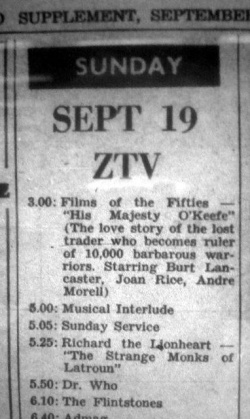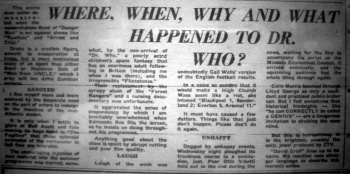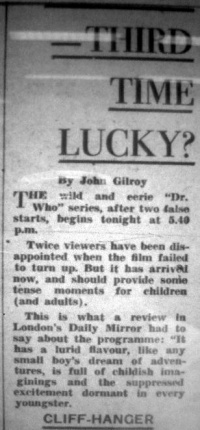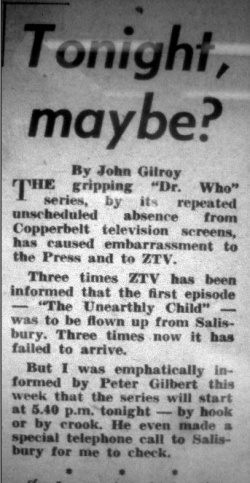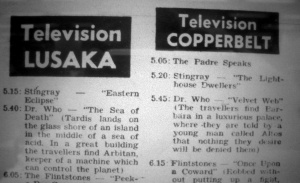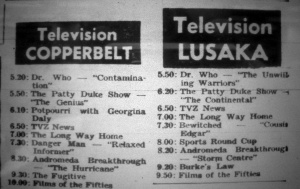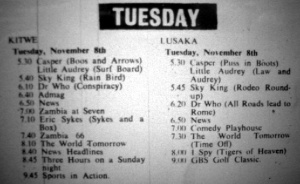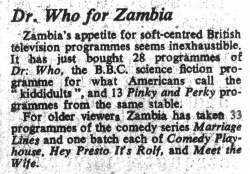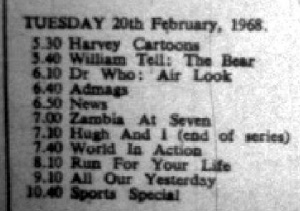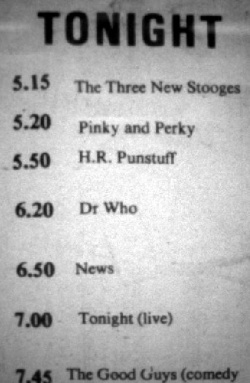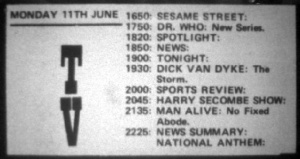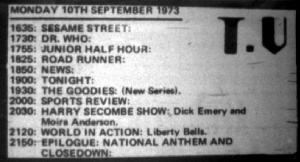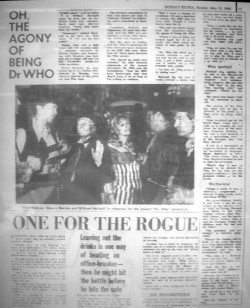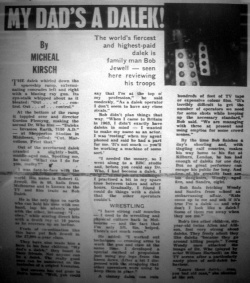Zambia
ZAMBIA is in south central Africa. It is bordered by Rhodesia.
Profile
| Country Number (10) | 1965 | FIRST WAVE |
| Region | Africa | Commonwealth |
| Television commenced | 1961 | |
| Colour System | 1979 | PAL |
| Population | 1966 | 3.65 million |
| TV Sets | 1966 | 11,118 |
| Population | 1976 | 4.64 million |
| TV Sets | 1976 | 22,500 |
| Language/s | English |
Television Stations / Channels
Zambia began its television service in 1961.
There is only one national television broadcaster, Zambia Broadcasting Corporation (ZBC), which became Zambia Broadcasting Services (ZBS) in 1966, and Zambia National Broadcasting Corporation (ZNBC) in 1988. It was commonly known as ZTV.
In 1979 it was the first country to introduce the PAL colour system within Africa.
In the mid-1960s, ZTV operated from two regional stations: the northern station broadcasting from the Copperbelt / Kitwe district (on channel 4), and the southern station broadcasting from the capital, Lusaka (on channel 3). (Transmissions from Lusaka commenced from 25 December 1965.)
A third repeater was established in 1968 in Kabwe. The three stations were linked as a network by microwave interconnection.
Language/s
The principal language of Zambia is English.
DOCTOR WHO IN ZAMBIA
Zambia was the 10th country to screen Doctor Who, and the third in Africa (see Selling Doctor Who).
BBC Records
Zambia is named in the list of 27 countries in The Making of Doctor Who (1972 Piccolo edition).
The Seventies records a sale of "(36)" stories by 28 February 1977. The Handbook, however, identifies 38; 26 for Hartnell and 12 from Troughton. This total agrees with the number of stories that did air, per the story tables below.
In DWM, Zambia is identified in 37 story Archives: the same as above, but with the single omission of the first serial, A.
Stories bought and broadcast
WILLIAM HARTNELL
Twenty-six stories, 117 episodes:
| A | An Unearthly Child | 4 |
| B | The Daleks | 7 |
| C | Inside the Spaceship | 2 |
| D | Marco Polo | 7 |
| E | The Keys of Marinus | 6 |
| F | The Aztecs | 4 |
| G | The Sensorites | 6 |
| H | The Reign of Terror | 6 |
| J | Planet of Giants | 3 |
| K | The Dalek Invasion of Earth | 6 |
| L | The Rescue | 2 |
| M | The Romans | 4 |
| N | The Web Planet | 6 |
| P | The Crusade | 4 |
| Q | The Space Museum | 4 |
| R | The Chase | 6 |
| S | The Time Meddler | 4 |
| T | Galaxy 4 | 4 |
| U | The Myth Makers | 4 |
| W | The Massacre | 4 |
| X | The Ark | 4 |
| Y | The Celestial Toymaker | 4 |
| Z | The Gunfighters | 4 |
| AA | The Savages | 4 |
| BB | The War Machines | 4 |
| CC | The Smugglers | 4 |
Zambia therefore bought GROUPs A to F of the William Hartnell stories (the only other country to buy this run of 117 episodes was Barbados).
The programme was supplied as 16mm black and white film prints with English soundtracks.
Origins of the Prints?
Zambia's prints of the first four William Hartnell stories were definitely sourced from Rhodesia / Zimbabwe, which was the previous African country to screen those eleven stories. Both Zambia and Rhodesia's scheduled debut of the series had been delayed by three weeks.
Trade sanctions imposed on Rhodesia in February 1966 may have prevented Zambia from sourcing films from there. It's possible that Rhodesia was completely removed from that particular bicycling chain or its position as the second country shifted; in which case, Zambia received the films directly from its supplier, which was most likely to be Gibraltar, since both countries aired the same set of seventeen stories / 81 episodes.
The 7 December 1966 edition of London Times reported that Zambia had purchased "28 programmes of Dr Who, the BBC science fiction programme for … "kiddults"." That block of episodes would be The Romans through to The Time Meddler, which had already started being broadcast by the time that issue was published.
As for the later season three serials, these were either supplied from the BBC directly, or bicycled from Barbados.
PATRICK TROUGHTON
Twelve stories, 68 episodes:
| FF | The Highlanders | 4 |
| GG | The Underwater Menace | 4 |
| HH | The Moonbase | 4 |
| JJ | The Macra Terror | 4 |
| KK | The Faceless Ones | 6 |
| NN | The Abominable Snowmen | 6 |
| OO | The Ice Warriors | 6 |
| PP | The Enemy of the World | 6 |
| The Web of Fear | 6 | |
| XX | The Seeds of Death | 6 |
| YY | The Space Pirates | 6 |
| ZZ | The War Games | 10 |
Zambia therefore bought GROUP B, most of D, and F of the Patrick Troughton stories.
The programme was supplied as 16mm black and white film prints with English soundtracks.
Origins of the Prints?
Zambia was the only African country to screen this set of twelve Troughtons. The season four stories were probably sourced from Uganda.
It's possible that The Faceless Ones was sourced from New Zealand in 1970, but held over until 1973: see the page for that story for more details.
The four season five stories were probably bicycled from Gibraltar.
The three season six serials may have been previously used in Singapore or Gibraltar, or given the early 1976 airdates, perhaps they were part of the set returned from Australia in mid-1975?
It's not clear why Zambia TV skipped over the six stories from Fury from the Deep to The Krotons. One likely explanation is that when the BBC offered ZTV more stories, the sales rights on those six had recently expired and were no longer available to purchase, leaving just the final three serials of that season still available within their sales rights period (which was usually five to seven years after the initial UK screening).
Transmission
WILLIAM HARTNELL
KITWE / COPPERBELT
The series was scheduled to commence from Sunday, 19 September 1965, at 5.50pm, however the films were not received from Rhodesia / Zimbabwe in time, so the scheduled programme was replaced with an episode of the Canadian adventure series, The Forest Rangers.
Interestingly, Rhodesia's own intended debut of the series was similarly delayed by a few weeks (due probably to the non-arrival of the films (from Nigeria?), and The Forest Rangers used to plug the gaps there as well!
Doctor Who was re-scheduled by ZTV for the following week, but the 26 September 1965 screening was also pre-empted by The Forest Rangers, again due to non-receipt of the Doctor Who films from Rhodesia.
The TARDIS again failed to materialise on 3 October 1965. The Forest Rangers aired instead.
Third time lucky? Sadly, no: the 10 October 1965 screening was also pre-empted.
Success! On Sunday, 17 October 1965, at 5.40pm, after four weeks of delays, Doctor Who finally went to air on ZTV.
The time changed to 5.45pm from 14 November with the second serial, The Daleks. In April, the series moved to Saturdays, but for the first week of the change, an episode aired on Saturday as well as Sunday, 2 and 3 April.
There was another day change from 7 June 1966 – now Tuesdays at 6.10pm - where it remained for the rest of the run, which came to an end on 6 June 1967, with part four of The Time Meddler.
The series aired over a period spanning 87 weeks, but with there being only 81 episodes to account for, there must have been six weeks on which no episode aired. These pre-emptions appear to have been mainly in February / March 1967 – see TV listings below. (There was no episode on 21 February and 9 May of that year.)
- NOTE: TV listings for Kitwe / Copperbelt were not available beyond June 1967, so further details for screenings of Doctor Who in that area are unknown.
LUSAKA
TV broadcasts were introduced to the southern regions of Zambia from 25 December 1965.
Doctor Who commenced in Lusaka from Sunday, 13 March 1966, at 5.40pm. However, rather than beginning from the start with An Unearthly Child, the Lusaka screenings started with The Keys of Marinus, which had begun in Kitwe / Copperbelt only the week before (6 March). Lusaka would be supplied with the same film print used by Kitwe until at least 1968.
The day of the week and timeslots for Lusaka changed to match those of the Kitwe broadcasts, before settling in on Tuesdays at 6.20pm from August 1966.
The run concluded on 13 June 1967, a week after Kitwe, with The Time Meddler part four. The Lusaka run also played six weeks more than the number of available episodes. The pre-emptions seem to have occurred in March / April 1967.
Eight months later Doctor Who returned to the Lusaka region; from Tuesday 6 February 1968, at 6.10pm, re-commencing from where the previous run had ended. (NOTE: The TV listings were not printed until 20 February 1968, which had a billing for Galaxy 4 part three, so the 6 February start-date is assumed. It is also presumed that the same set of episodes aired a week earlier in Kitwe / Copperbelt.)
Only two serials aired – Galaxy 4 and The Myth Makers – before the series took a one week break. (Replaced by Dennis the Menace.) Screenings resumed from 9 April 1968 (presumably with The Massacre).
The series moved to 5.40pm in June 1968. There was another break of a week between The Ark and The Gunfighters. Further pre-emptions occurred during The War Machines (was there perhaps a problem with the delivery of the films between Kitwe and Lusaka?)
There were several timeslot changes, from 6.00pm, to 6.10, then 6.20pm.
The run concluded on 5 November 1968, with (presumably) part four of The Smugglers.
Fate of the Prints?
The seasons one and two William Hartnell serials were likely sent to Mauritius, the only other east African country to screen the same set of episodes. (The only other African country to air the same episodes shortly after Zambia was Sierra Leone, but it's far more likely that that set of films was supplied to them by Nigeria.)
However, the season three serials were most likely sent to Sierra Leone, since it was the only other African country to screen those episodes.
PATRICK TROUGHTON
When the series returned 17 months later, it was with a new Doctor. A further 16 week run commenced from Wednesday, 8 April 1970, at 5.50pm; BBC Records indicate these were The Highlanders to The Macra Terror. (The series took a one week break between serials on 3 June 1970.)
The microwave network across the country had been established for a few years, so presumably by this time the same episode was screened in both regions at the same time.
Neither The Tenth Planet or The Power of the Daleks screened in Zambia (most likely on account of the latter having been withdrawn from sale under Terry Nation's agreement with the BBC), so viewers were offered no on-screen explanation for the change in appearance of the lead character.
It wasn't for another three years that Doctor Who aired in Zambia again. A 30 week / episode run commenced on Monday, 11 June 1973, at 5.50pm. There was a change of time to 6.20pm with the fifth episode, then to 5.30pm from August 1973 to the end of the run, which was 31 December 1973. The serials that aired would have been The Faceless Ones to The Web of Fear (skipping The Evil of the Daleks and The Tomb of the Cybermen).
25 months later, on Thursday, 5 February 1976, a 22-week run commenced. The timeslot changed several times, from 6.35pm at the start of the run, to 6.00pm at the end. BBC Records indicate these 22 weeks were the final three Patrick Troughton serials. (Zambia therefore skipped over six serials: RR, SS, TT, UU, VV, and WW.)
The 185th and final episode of Doctor Who to air in Zambia screened on 1 July 1976.
There is no clear record that Zambia screened Doctor Who again, even after the switch to colour in 1979.
Fate of the Prints?
The season four Troughtons were probably destroyed or returned to the BBC.
The season five episodes were probably returned to the BBC or destroyed.
The season six episodes were probably returned to the BBC or destroyed. Zambia was the last country to screen the now-missing serial The Space Pirates.
TV listings
| ← AIRDATES ...... (CLICK ICON TO GO TO TABLE SHOWING EPISODE BREAKDOWN AND AIRDATES - N/S = story title is Not Stated) |
TV listings have been obtained from the newspapers Zambia News, Zambia Mail and Times of Zambia. The listings in the News were in a "Radio and TV Guide" section.
The listings always gave the title as "Dr Who".
The 19 September 1965 Zambia News featured a brief preview of new series that was due to screen "next week". The text of this was taken from BBC publicity material, and gave a short plot synopsis from Mission to the Unknown, which had been recorded in August but was not due to screen in the UK until 6 October. (The very same text had also appeared a few weeks earlier, in the Rhodesia Herald issue dated 4 September 1965.)
For the four weeks that the series' debut was delayed, the Zambia News carried a brief explanation as to why this had happened.
- 26 September 1965: WHERE, WHEN, WHY AND WHAT HAPPENED TO DR WHO?
- 3 October 1965: "... once again he failed to appear... "
- 10 October 1965: THIRD TIME LUCKY?
- 17 October 1965: TONIGHT, MAYBE?
The News and Mail carried titles for the majority of the episodes for the 1965 to 1967 run. For the first four serials, the News carried short synopses.
For the 1968 run, only five of the 36 episodes were identified by title.
On 14 May 1966, the News printed an interview with William Hartnell (OH THE AGONY OF BEING Dr WHO) that had originated in the UK Daily Mirror (April 1966 – see Ghana.)
The 3 July 1966 issue of the News TV and Radio Extra featured an interview with Dalek operator Robert Jewell (MY DAD'S A DALEK!)
Some printing oddities occurred in the papers: for the second serial, the enemy of the Daleks were named as "Thaals". Part four of The Keys of Marinus was given as "Shows of Terror". Part three of The Sensorites was billed by the unusual name of "Contamination"! Part two of The Reign of Terror was "Quest of Madame Guillotine". The last three episodes of The Web Planet were also mixed up or duplicated. Galaxy 4 part three was listed as "Air Look".
Between October 1966 and April 1967 there were quite a few newspapers missing. As noted above, there are six weeks more than the number of episodes; presumably there were pre-emptions on the dates for which no paper was available. (If so, the majority of these 'breaks' were between episodes of The Space Museum and The Chase.)
During the 1968 run, the Zambia Mail did not always have TV listings; instead an apology was printed that that they were unable to publish the listings "as they were not available from ZTV at the time of going to press". This means the start date of 6 February 1968 of that run is only assumed.
None of the listings for the 1970, 1973 and 1976 runs had episode titles: the listings give the title as "Dr Who".
